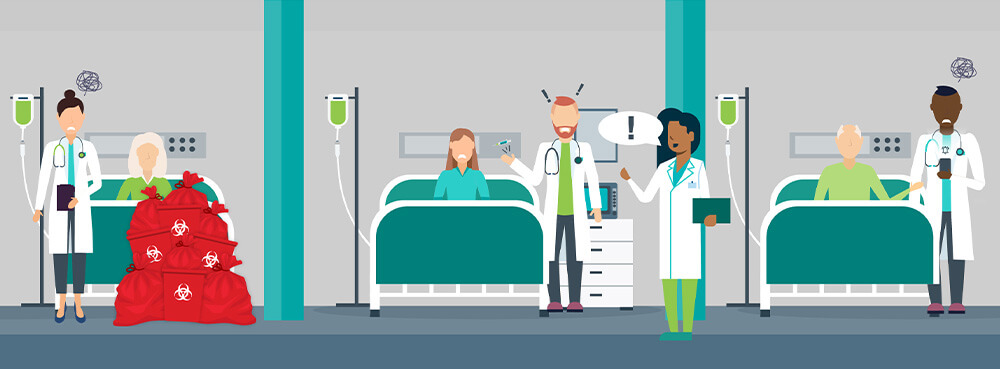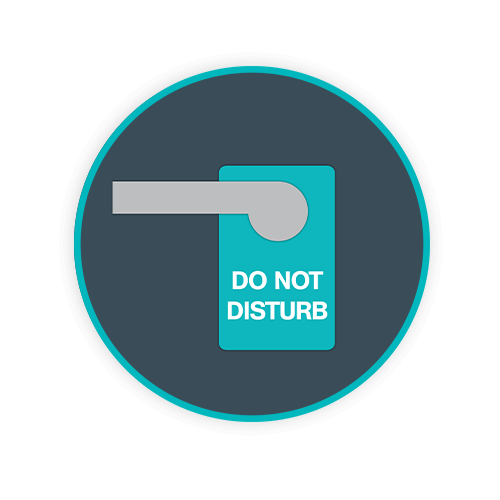7 Practical Solutions for Reducing Patient Interruptions

In today’s world, distractions are a constant challenge, but this is particularly true for healthcare environments, where interruptions are ever-present. Whether it’s text messages or questions from a coworker, there is no lack of distractions that can drag clinicians’ attention away from their patients. One study for instance found that a nurse may be interrupted up to 13 times in one hour. These distractions can become a big problem when they interrupt a clinician dealing with high-risk tasks such as prescribing medication.
The good news is that, as inescapable as these distractions can be, there are a variety of strategies to adopt that can help minimize interruptions and help drive a patient-focused environment. Furthermore, these solutions can quickly be implemented without the expense of additional training or the cost of significant time.
SOLUTIONS COVERED IN THIS BLOG:
1 / Establish Dedicated Distraction-Free Zones
3 / Best Times for Necessary Interruptions
4 / Create Visual Cues to Discourage Interruptions
5 / Create a System of Low Priority Communication
6 / Prevent Medical Waste from Wasting Your Staff’s Time
7 / A Few Moments of Planning Can Reduce Interruptions for the Long-Term
Establish Dedicated Distraction-Free Zones
One effective technique for reducing interruptions in critical task areas is to introduce a distraction-free zone. This concept uses visual markers such as colored tape or even walls to cordon off areas where critical work takes place.
These simple reminders that individuals who are inside these zones are not to be interrupted can prevent distractions that can lead to dangerous mistakes. You can also use this concept for areas such as medication preparation or even medical-surgical units to prevent interruptions that could prove very costly.
Device Management
Technology has made incredible strides toward improving productivity and effectiveness in healthcare delivery. But in some cases, it may actually prove a hindrance. This occurs when technology actually provides an unnecessary distraction, such as personal text messages arriving in the workplace or low-priority alerts that are indistinguishable from more important ones.
Technology is certainly not the enemy, but you should look at how employees are using it and introduce policies such as requiring personnel to silence or store personal devices during active hours. This can help to prevent unnecessary distractions. For personnel who must carry a mobile device, arranging for temporary transfers to other staff members can provide periods of undisturbed time. In many cases, simply changing the tones of alerts can even help to prevent interruptions during critical moments and allow devices to bolster productivity, not harm it.
Best Times for Necessary Interruptions
Not every interruption may be negative, in fact, in healthcare settings, some may be critical. However, the timing could still be poor. So, set aside times for important communications and ensure others are aware of these times so as to avoid interruptions when employees need to pay attention to their work without interruptions.
Further, when interruptions or updates are necessary during critical processes, making sure that staff is prioritizing intervening during transitional moments, such as moving between patients, can help to prevent errors that may occur during complex work.
Create Visual Cues To Discourage Interruptions
When healthcare providers are performing critical functions throughout the facility during which patient interruptions may cause harm, creating a visual cue can help. Nurses and other providers can also communicate to others not to interrupt them by using visual cues, such as colored vests, aprons, or other wearable items. It is necessary to ensure everyone, both staff and patients are clearly aware of its purpose, and then it must be readily available and not overused to ensure its effectiveness. However, this remains a powerful technique that can be readily implemented at most facilities.
Create a System for Low Priority Communication
Many interruptions occur simply due to the need to communicate necessary, but low-priority messages, such as asking questions that don’t require an immediate response. These communications are critical but generally should not interrupt healthcare workers during their daily work. Instead, reserve them for a designated low-priority channel.
You could email, fax, text, or use another form of communication you have designated for routine communication that does not require immediate contact. A dedicated channel for these messages will allow staff to perform routine communications during non-critical times, reduce frustrations, and potentially raise efficiency, in addition to preventing patient interruptions.
Prevent Medical Waste from Wasting Your Staff’s Time

Taking excessive time to deal with waste not only slows down staff but also creates another window for patient interruptions. Thus, optimizing your waste management strategy is a great opportunity to close this gap. You can easily start improving your waste disposal system by carefully placing, clearly segregating, and appropriately color-coding your containers. Disposal should be able to occur immediately after it is generated in a nearby container to minimize time wasted moving through the facility. Bins designed for installation at the site of waste generation, such as wall-mounted sharps containers or ones made to be mobile for easy movement to the areas needed prove themselves invaluable to a streamlined workflow.
Waste stream segregation reduces cost and time spent on final disposal down the line, while proper color coding enables staff to easily ensure sharps, biomedical waste, pharmaceuticals, and more all go to the correct stream without a second thought. Relying on a waste management partner like Daniels Health means they can walk you through the process of optimization to ensure waste disposal is a seamless and interruption-free part of the staff’s workflow every day.
A Few Moments of Planning Can Reduce Interruptions for the Long-term
Given the serious potential consequences of unchecked distractions in a medical setting, reducing patient interruptions is a worthwhile goal. Not only will it help to prevent mistakes from occurring, but a more efficient practice is sure to improve patient satisfaction scores by reducing wait times and patient frustration.
Fortunately, several steps go a long way toward alleviating the issue of interruptions. Establishing distraction-free zones, creating a policy for digital device usage, setting aside specific and appropriate times to deal with potential interruptions, maintaining a channel for low-priority communication, offering visual cues for staff to avoid interruptions, and optimizing waste disposal times are all great ways to begin minimizing frequent sources of distraction and wasted time. When the plan is efficient, so is the facility! Want to talk about strategies for making your practice’s waste disposal more streamlined and efficient? Reach out to Daniels Health to begin your journey to a customized solution tailored to your practice’s specific needs.
Let's Talk!
Your time is valuable, and we don’t want to play hard to get. You can either phone us directly on the details listed on our contact page, or feel free to fill out this short form and one of our team members will get back to you as quickly as possible.
